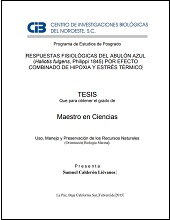Respuestas fisiológicas del abulón azul (Haliotis fulgens, Philippi 1845) por efecto combinado de hipoxia y estrés térmico
Author
SAMUEL CALDERÓN LIÉVANOS
Metadata
Show full item recordAbstract
En el presente estudio se buscó comprender las respuestas que tiene el abulón azul (Haliotis fulgens) ante el efecto combinado de la temperatura (T°C) y oxígeno disuelto (OD). Lotes de organismos de 3.1 ± 0.35 cm, se sometieron a condiciones extremas de hipoxia para estimar sus límites de tolerancia a diferentes temperaturas y se expusieron a condiciones extremas (1.0 mgO₂/L) para evaluar las respuestas fisiológicas y supervivencia. Se estimó la tasa respiratoria (TR) por medio de un oxímetro Microx XT, y cambios en la composición de hemolinfa: paquete celular (CC) cuantificado con ayuda de un contador de células Multisizer 3, contenido de hemocianina (HC) por espectrofotometría directa (275 nm), proteínas totales (PT) usando el método de BCA, glucosa (GLU) con el método GOD-PAP y lactato (LAC) con el Kit comercial Sigma de Randox. Además, los organismos se expusieron a diferentes combinaciones de OD-T°C para ajustar modelos de superficie de respuesta a diferentes tiempos y se evaluó también la capacidad de los organismos para recuperarse de las condiciones extremas al ser regresados a condiciones normales. Los resultados indican que el abulón azul a 17ºC reduce su TR en un 40%, mientras que en 23 y 26ºC se disminuye en un 75% (P<0.05). En la hemolinfa los abulones presentaron reducciones en el número de células de entre 67-72% (P<0.05), mientras que se presentaron incrementos significativos en la HC y las PT entre el 18-21% y 30-37%, respectivamente. La GC tuvo aumentos del 20% a 17°C, mientras que a 23 y 26ºC este fue arriba del 100% (P<0.05). En el caso del LAC los incrementos no fueron significativos (10-20%) (P>0.05). Cuando los organismos fueron expuestos a hipoxia extrema sostenida a 17ºC la supervivencia fue del 100%, mientras que a 23 y 26ºC el 50% de la mortalidad se presentó alrededor de las 30 y 40 h respectivamente, presentando capacidades de recuperación arriba del 80% cuando son regresados a condiciones de normoxia [...] The present study was aimed at understanding the responses of the green abalone (Haliotis fulgens) to the combined effects of temperature (T°C) and dissolved oxygen (DO). Groups of organisms 3.1 ± 0.35 cm, were exposed to extreme conditions of hypoxia to estimate their tolerance to different temperatures, and also to extreme conditions (1.0 mgO₂/L) to evaluate the physiological and survival responses. The respiration rate (RR) was estimated using an oximeter Microx XT, and changes in the composition of hemolymph: Cells count (CC) quantified using a Multisizer 3 cell counter, hemocianine content (HC) by direct spectrophotometry ( 275 nm), total protein (TP) using the BCA method, glucose (GLU) with the GODPAP method and lactate (LAC) with a commercial Sigma Randox kit. In addition, organisms were exposed to different combinations of OD-T°C to fit response surface models at different times, and the abalones capacity to recover from extreme conditions once returned to normality. The results indicate that at 17°C the TR decreases by 40%, while at 23 and 26ºC the decrease reaches 75% (P <0.05). In the hemolymph, abalone showed reductions in the number of cells between 67- 72% (P <0.05), whereas significant increases occurred in the HC and PT between 18-21% and 30-37% respectively. The GC had increases of 20% at 17°C, while at 23 and 26°C it increased over 100% (P <0.05). In the case of LAC increases were not significant (10-20%) (P> 0.05). When the organisms were exposed to sustained extreme hypoxia levels, survival was 100% at 17ºC, while at 23 and 26ºC 50% of the mortality occurred around 30 and 40 h, respectively. Recovery capacity was above 80% for all treatments [...]
Collections
Related items
Showing items related by title, author, creator and subject.
-
PROMOCIÓN DEL PERIFITON PARA EL CULTIVO DE CAMARÓN BLANCO: HACIA UNA ACUICULTURA ECOLÓGICA
DOMENICO VOLTOLINA LOBINA; JUAN MANUEL AUDELO NARANJO; MARIA DEL ROSARIO PACHECO MARGES -
Suelo y Erosión
YOLANDA LOURDES MAYA DELGADO


